
Volvo Xc90 2002–present

| Volvo XC90 | |
|---|---|
 |
|
| Overview | |
| Manufacturer | Volvo Cars |
| Production | 2002–present P2: 2002–present (1st generation) SPA: 2014–present (2nd generation) |
| Body and chassis | |
| Class | Mid-size luxury crossover SUV |
| Body style | 5-door SUV |
| Layout |
|
The Volvo XC90 is a luxury crossover SUV manufactured and marketed by Volvo Cars since 2002 and now in its second generation.
The first generation was introduced at the 2002 North American International Auto Show and used the Volvo P2 platform shared with the first generation Volvo S80 and other large Volvo cars. It was manufactured at Volvo's Torslandaverken. Volvo moved production equipment of the first generation to China and ended Swedish production at the end of 2014, renaming the car as the Volvo XC Classic (or Volvo XC90 Classic). The XC90 was Volvo's top-selling vehicle in the United States and also Volvo's best selling model worldwide in 2005 with 85,994 cars sold.
In the end of 2014, the second generation XC90 was introduced. It is based on a new global platform, called Scalable Product Architecture or SPA for short. Both generations of the XC90 have won Motor Trend's SUV of the Year award in their debuts.
First generation (2002–2014)
| First Generation | |
|---|---|

Volvo XC90 pre-facelift (AU)
|
|
| Overview | |
| Also called | Volvo XC Classic (China) |
| Production |
|
| Model years |
|
| Assembly |
|
| Designer | Doug Frasher (1999) |
| Body and chassis | |
| Platform | Volvo P2 platform |
| Powertrain | |
| Engine |
|
| Transmission |
|
| Dimensions | |
| Wheelbase |
|
| Length |
|
| Width |
|
| Height | 1,784 mm (70.2 in) |
| Curb weight | 2,020–2,160 kg (4,450–4,760 lb) |
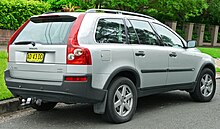

In January 2001, Volvo débuted its Adventure Concept Car at the North American International Auto Show, to gauge reaction to the styling and features of its upcoming SUV. In November 2001, Volvo released a teaser image showing the frontal styling of the production version, named the XC90. Notable as Volvo's first SUV model, the styling of the XC90 recalled the concept. In January 2002, the full XC90 unveiling occurred, at the North American International Auto Show. Production began in August 2002, after Volvo's traditional mid-year shutdown, with the first XC90s coming out of the Torslanda factory in Sweden.
At its North American launch for the 2003 model year, the XC90 was presented with a choice of two trim levels, the 2.5 T and the T6. The 2.5 T was the entry level version and offered a 2.5-litre B5254T2 "T5" turbocharged inline-five engine, producing 208 hp (155 kW) and 236 lb·ft (320 N·m) mated to an Aisin co-developed five-speed AW55-50/51 automatic. The T6 offered a 2.9-litre B6294T twin-turbocharged inline-six with 268 hp (200 kW) and 280 lb·ft (380 N·m) mated to a GM-sourced, Volvo-modified four-speed 4T65EV/GT automatic. While the 2.5T came standard with front-wheel drive, a Haldex Traction all-wheel drive (AWD) system was optional. The T6 was offered only with the AWD system.
A Yamaha V8 engine was added in 2005. This 4.4-litre Volvo B8444S engine produced 288 hp (215 kW) for the first few models later upgraded to 311 hp (232 kW) and 325 lb·ft (441 N·m) of torque. Volvo sold just over 40,000 XC90 units in North America that year.
The XC90 won the North American Car of the Year award and Motor Trend magazine's Sport/Utility of the Year for 2003.
The ex-host of Top Gear, Jeremy Clarkson, has owned three of these vehicles, and claims they were designed by someone who must've had children due to its practicality.
Facelifts
2007 update
The XC90 was updated for 2007 with a restyled front and rear and a revised interior. The 235 hp (175 kW; 238 PS) 3.2 L SI6 straight-6 engine replaced the 208 hp (155 kW; 211 PS) B524T2 straight-5 in the base model for the US market. The 2007 XC90 debuted in April 2006 at the New York Auto Show.
-

2007 update
-

2007 update
2009, 2010, and 2012 updates
For model year (MY) 2009 model, the XC90 received a new rear logo, featuring larger lettering with wider spaces between the "VOLVO" letters.
In 2010, all XC90 models received painted wheel arches (previously they were optional). In addition, a new, larger, circular Volvo logo appeared on the front grille.
For MY 2012, new LED tail-lights became available on certain models, although entry-level models retain the previous style. For MY 2013, the XC90 received a cosmetic refresh that included standard LED daytime running lights and taillights, and exterior revisions including body colour bumpers, rocker panels and silver trim replacing black plastic trim.
The refreshed model went on sale during late spring 2012 with a base price of US$40,395 for a front-wheel drive base model. For the 2014 model year the base price is US$39,700.
-

2009 update
-
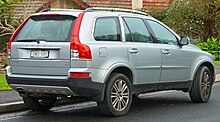
2009 update
First generation models
XC90
XC90 Ocean Race
In early 2005 a special version called Ocean Race Edition was unveiled. Special blue colour, leather interior with contrast stitching and special interior trim. A total of 800 were made.
-

Volvo XC90 Ocean Race pre-facelift
XC Classic
The first generation Volvo XC90 continues to be sold in China as the XC Classic. It is being produced at the new Volvo factory located in Daqing, Heilongjiang Province, with the necessary tooling shipped over from Sweden. Equipment levels were changed compared to the international versions and only one engine, a 2.5L turbo petrol 5-cylinder engine with 220 hp, is available. All XC Classic come with AWD as standard and either a 5-speed manual or 5-speed automatic transmission. It is priced below the second generation XC90.
-
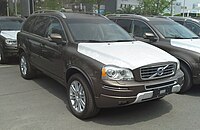
XC Classic (CN)
-
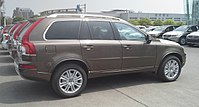
XC Classic (CN)
Engines
| Model | Engine code | Year(s) | Power | Torque @rpm | Displacement | Comment |
|---|---|---|---|---|---|---|
| 2.5T 2.5T AWD |
B5254T2 | 2003–2006 | 155 kW (211 PS; 208 bhp) | 320 N·m (240 lb·ft) @ | 2,500 cc (152.6 in3) | I5 turbo |
| 3.2 3.2 AWD |
SI6 | 2007–2014 | 175 kW (238 PS; 235 bhp) | 320 N·m (240 lb·ft) @ | 3,192 cc (194.8 in3) | I6 |
| T6 AWD | B6294T | 2003–2005 | 200 kW (272 PS; 268 bhp) | 380 N·m (280 lb·ft) @ | 2,922 cc (178.3 in3) | I6 twin-turbo |
| V8 AWD | B8444S | 2005–2011 | 232 kW (315 PS; 311 bhp) | 440 N·m (320 lb·ft) @ | 4,414 cc (269.4 in3) | V8 |
| Model | Engine code | Year(s) | Power | Torque @rpm | Displacement | Comment |
|---|---|---|---|---|---|---|
| 2.4D | D5244T5 | 2009 | 120 kW (163 PS; 161 bhp) | 340 N·m (250 lb·ft) @ 1750 | 2,400 cc (146.5 in3) | I5 turbo |
| D4 | D5244T5 | 2013 | 120 kW (163 PS; 161 bhp) | 340 N·m (250 lb·ft) @ | 2,401 cc (146.5 in3) | I5 turbo |
| D5 D5 AWD |
D5244T | 2003–2004 | 120 kW (163 PS; 161 bhp) | 340 N·m (250 lb·ft) @ | 2,401 cc (146.5 in3) | I5 turbo |
| D5 D5 AWD |
D5244T4 | 2005–2011 | 136 kW (185 PS; 182 bhp) | 400 N·m (300 lb·ft) @ | 2,400 cc (146.5 in3) | I5 turbo |
| D5 D5 AWD |
D5244T18 | 2012–2014 | 145 kW (197 PS; 194 bhp) | 420 N·m (310 lb·ft) @ | 2,400 cc (146.5 in3) | I5 turbo |
Safety
The Volvo XC90's front end is designed to absorb frontal impacts and also deflect any pedestrians up on to the hood of the vehicle rather than underneath the vehicle. Volvo has patented the unique frontal structure that features crumple zones, and predetermined positions for the engine and other ancillaries during a frontal impact.[citation needed]
The XC90's roof is reinforced with ultra-high-strength steel to help prevent a collapse in the passenger cavity in the event of a roll-over. This Volvo system is marketed as ROPS, and is closely associated with the Roll Stability Control (RSC), electronic stability control (DSTC), and SIPS systems of Volvo to prevent and ultimately minimise accident forces. The National Highway Traffic Safety Administration measures the roll-over risk of the 2013 XC90 as 17.9%. The max. sideway thrust is 0.77g.
The XC90's rear structure has been designed to absorb impact energy, with occupants are also protected by a whiplash protection system. Marketed as WHIPS, the system cradles the occupants during a rear end collision.
The Insurance Institute for Highway Safety awarded the Volvo XC90 their Top Safety Pick award. The XC90 was granted the IIHS's highest rating of "good" in front, side, rear and roof strength tests and has Electronic Stability Control as standard equipment to receive the award.
The industry-first Roll Stability Control was first introduced in XC90 in 2003.
At the end of July 2007, Volvo Car Corp. announced the recall of 42,211 2005 model year XC90s for risk of battery short circuit and fire. The vehicles were manufactured in the Swedish Torslanda Plant between 7 June 2004, and 13 May 2005. The recall only applies to cars in the US and Canada. There have been no reports of short circuiting in the vehicles.[citation needed]
| Small overlap front | Good1 |
| Moderate overlap front | Good |
| Side (2005 - 2014 models) | Good |
| Roof strength | Good2 |
| Head restraints & seats | Good3 |
- 1vehicle structure rated "Good"
- 2strength-to-weight ratio: 4.51
- 3seat/head restraint geometry rated "Good"
Second generation (2014–present)
| Second Generation | |
|---|---|

2015 Volvo XC90 (SE)
|
|
| Overview | |
| Production | September 2014–present |
| Model years | 2015–present |
| Assembly |
|
| Designer |
|
| Body and chassis | |
| Class | Mid-size 4, 5 or 7-seatluxury crossover SUV |
| Platform | Scalable Product Architecture platform |
| Related | Volvo S90 II Volvo V90 II |
| Powertrain | |
| Engine |
|
| Transmission | 8-speed Aisin AW TG-81SC automatic |
| Hybrid drivetrain | Plug-in hybrid |
| Battery | 9.2 kWh lithium-ion battery |
| Dimensions | |
| Wheelbase | 2,984 mm (117.5 in) |
| Length | 4,950 mm (194.9 in) |
| Width | 2,008 mm (79.1 in) |
| Height | 1,776 mm (69.9 in) |
| Curb weight | 2,078–2,343 kg (4,581–5,165 lb) |
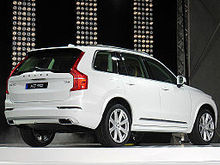
In May 2012 Volvo announced that the second generation XC90 will go into production in late 2014, with orders being taken in 2014 and the vehicle officially going on sale in 2015. The SUV will be sold in Europe, Asia and North America. Volvo expects the United States to account for at least a third of global sales.
The new XC90 is based on Volvo's new platform, marketed as Scalable Product Architecture (SPA) technology which features a stronger platform offering weight reduction while improving safety and efficiency.[citation needed]
The vehicle is longer, wider and lower than its predecessor. All engines in the XC90 will be 2.0-litre four-cylinder Drive-E powertrains with Volvo's eight-speed Geartronic transmission. The line-up will include two petrol engines: a twincharged 320 hp T6, producing 400 nm of torque and a turbocharged 254 hp T5, producing 350 nm of torque, two diesel engines: a twin turbo 235 hp D5, producing 470 nm of torque and a turbocharged 190 hp D4, producing 400 nm of torque. The top-of-the-line model is the XC90 Twin Engine, a plug-in hybrid which combines the more powerful petrol engine at the front with an electric motor at the rear to produce 400 hp and 640 nm of torque.
The First Edition of the all-new Volvo XC90, 1,927 individually numbered cars only available for sale via digital commerce, sold out in 47 hours after orders opened on 3 September 2014. All 1,927 of the First Edition models, which could feature either the Petrol T6 or Diesel D5 engine, were finished in Onyx Black and feature 21-inch alloy wheels and include every available vehicle option. The limited production run number represents the year the Swedish brand was launched, with each model fitted with uniquely numbered tread plates and a distinctive rear mounted badge, with customers able to select their XC90 First Edition numbers. Number 1 was allocated to Carl XVI Gustav, the King of Sweden, with number 10 going to Zlatan Ibrahimović, Swedish professional footballer.
Design

The new XC90 has a redesigned chassis with double wishbone front suspension and a new integral link rear axle incorporating transverse leaf springs of lightweight material. The new XC90 can also be equipped with electronically controlled air suspension with a choice of five modes.
The interior features a 9" tablet-like touch screen control console along with steering wheel controls and voice-control system, all linked to an interface, marketed as Sensus, which allows for access to cloud-based apps including Internet radio, connected navigation, parking, music streaming, OS mirroring Apple and Android devices in the touch screen display, and a Wi-Fi hot spot for using a tablet in the car. Other features include a gear lever made of Orrefors crystal as well as diamond-cut controls for the start/stop button and drive mode control, located on the centre console between the driver and passenger seats.
The highest level audio system in the XC90 features a 1400W Class-D amplifier and 19 Bowers & Wilkins speakers as well as one of the first air-ventilated subwoofers in a car.[citation needed] Integrated into the car body, it turns the entire interior space into a large subwoofer. The latest sound processing software has been used to manage the timing of the sound and co-ordination of the speakers.
The vehicle's seats have also been redesigned with adjustable side bolsters, seat cushion extension and massage. The second row features three individual seats with recline adjustment. A sliding function can be used to create more legroom for the passengers in the third row or to increase loading space. An integrated child booster cushion in the centre seat is available. The Volvo XC90 seats 5 people or can be available with 3rd row seating which seats 7 people just like the BMW X5, Toyota 4Runner, Kia Sorento, Nissan Rogue, Dodge Journey, Mitsubishi Outlander, and the second generation GMC Acadia.
Volvo Cars' air purification system has been improved by adding a new carbon filter for more efficient capture of small, particles and pollen in the incoming air. The second generation XC90 offers a 360° view system capable of providing the driver with a birds-eye view, whereby information from all cameras is gathered and digitally integrated in a central processor to form a 360° image. The rear sensing system, marketed as Park Assist Pilot, offers automatic reversing into a parking bay.
The 2nd generation XC90 is the first Volvo to carry the company's new, more prominent iron mark, which has the iconic arrow aligned with the diagonal metallic slash across the grille along with t-shaped LED daytime running lights.[citation needed]
The car will be available in four trim levels, namely Kinetic (base trim level), Momentum, Inscription (a more luxurious trim) and R-design (a sportier trim).
Safety
The Second Generation Volvo XC90 SUV features a comprehensive and technologically sophisticated standard safety package (IntelliSafe), including two world first safety technologies: Run-off-road protection package and Auto brake at intersection. These Volvo safety features mean that the Second Generation Volvo XC90 is, as of 2015, the safest SUV in the world.
The Volvo XC90 safety systems include:
- Run-off-road protection package. In a run-off-road scenario, the all-new Volvo XC90 detects what is happening and the front safety belts are tightened to keep the occupants in position. To help prevent Spinal cord injury, energy-absorbing functionality between the seat and seat frame cushions the vertical forces that can arise when the car encounters a hard landing in the terrain.
- City Safety with auto brake in intersections. The XC90 is the first car in the world with technology that features automatic braking if the driver turns in front of an oncoming car. This is a common scenario at busy city crossings as well as on highways, where the speed limits are higher.
- IntelliSafe with City Safety has become the umbrella name for all of Volvo Cars' auto brake Collision avoidance functions, which are standard equipment in the new XC90. This equipment now covers vehicles, cyclists and pedestrians in front of the car during both day and night.
- Adaptive Cruise Control with Pilot Assist traffic jam assistant enables safe and comfortable semi-autonomous driving by automatically following the vehicle ahead in stop-and-go traffic. Acceleration, braking and now also steering are controlled automatically.
In the midst of the vehicle's Australian release in August 2015, the All-New 2016 XC90 was labelled by a major media source as being an SUV that will be the safest car in Australia. The Volvo brand has also made the claim that "By 2020, nobody shall be seriously injured or killed in a new Volvo."
EURONCAP tested a 2016 XC90, 5-door SUV with standard equipment. EuroNCAP regards the 2015 model as the overall best performer.NHTSA currently only recorded for rollover.
| NHTSA | Euro NCAP | ||
|---|---|---|---|
| Overall: | Overall: | ||
| Frontal – Driver: | Adult occupant: | 37 pts / 97% | |
| Frontal – Passenger: | Child occupant: | 24 pts / 87% | |
| Side – Driver: | Pedestrian: | 26 pts / 72% | |
| Side – Passenger: | Driver assist: | 13 pts / 100% | |
| Side Pole – Driver: | |||
| Rollover: |
The Insurance Institute for Highway Safety also crash-tested the XC90, and presented the following results (ratings from 'poor' to 'good'):
| Category | Rating |
|---|---|
| Small overlap front | Good1 |
| Moderate overlap front | Good |
| Side | Good |
| Roof strength | Good2 |
| Head restraints & seats | Good3 |
- 1vehicle structure rated "Good"
- 2strength-to-weight ratio: 5.18
- 3seat/head restraint geometry rated "Good"
T8

The T8 plug-in hybrid version of the XC90 is based on technology used in the Volvo V60 PHEV. The batteries are situated at the centre of the vehicle can be charged using an electric vehicle charger and can also store energy recovered by means of regenerative brakes. Volvo says that the XC90 T8 sacrifices no passenger or cargo space to accommodate the hybrid equipment. However, the tank capacity is reduced to 50 L (13.2 US gal; 11.0 imp gal) and there is no spare tire.
The vehicle emits 49 g/km of CO2 and has an all-electric range of 43 km (27 mi) under the New European Driving Cycle. Normal driving is conducted in the default hybrid mode, but the driver can push a button to switch to a mode that uses only electric power, with zero emission driving. Under the U.S. Environmental Protection Agency (EPA) tests, the XC90 T8 has an all-electric range of 14 mi (23 km), with some gasoline consumption (0.1 gal/100 mi), so the actual all-electric range is rated between 0 to 13 mi (0 to 21 km).
The EPA, under its five-cycle tests, rated the 2016 model year XC90 T8 energy consumption in all-electric mode at 58 kWh per 100 miles, which translates into a combined city/highway fuel economy of 53 miles per gallon gasoline equivalent (MPG-e) (4.4 L/100 km; 64 mpg-imp gasoline equivalent). When powered only by the gasoline engine, EPA's official combined city/highway fuel economy is 25 mpg‑US (9.4 L/100 km; 30 mpg‑imp).
Deliveries of the XC90 T8 PHEV began in the United States in August 2015. Sales in Europe totaled 2,653 units in 2015. Cumulative sales in the U.S. totaled 488 units up until February 2016. According to Volvo, sales of the plug-in variant represent 20% of Volvo XC90 global sales by mid-March 2016.
Technical data
| Specification | D4 FWD | D5 AWD | T5 AWD | T6 AWD | T8 Twin-Engine |
|---|---|---|---|---|---|
| Length | 4950 mm (194.9 in) | ||||
| Width | 2140 mm (84.3 in) | ||||
| Height | 1775 mm (69.9 in) | ||||
| Wheelbase | 2984 mm (117.5 in) | ||||
| Luggage area volume | 704 l (186.0 US gal; 154.9 imp gal) | ||||
| Seats | 7 | ||||
| Curb weight | |||||
| Tank Capacity | 71 L (18.8 US gal; 15.6 imp gal) | 71 L (18.8 US gal; 15.6 imp gal) | 50L (13.2 US gal; 11 imp gal) | ||
| Cylinders | In-line 4 (4 valves/cylinder) | ||||
| Engine | 2.0L Turbo Diesel | 2.0L Twin-turbo Diesel | 2.0L Turbo Petrol | 2.0L Turbocharged & Supercharged "twincharged" petrol | 2.0L Turbo Petrol with Supercharger and Electric motor (Twin Engine) |
| Displacement (cc) | 1969 | ||||
| Fuel economy (combined) | 5.8 | 7.7 | |||
| Max power output | 190 PS (140 kW) | 225 hp (168 kW) @ 4250 rpm | 245 PS (180 kW) | 320 PS (235 kW) @ 5700 rpm | 408 PS (300 kW) |
| Max torque | 400 N·m (295 lb·ft) | 470 N·m (347 lb·ft) @ 1750-2500 rpm | 350 N·m (258 lb·ft) | 400 N·m (295 lb·ft) @ 2200-4500 rpm | 640 N·m (472 lb·ft) |
| Acceleration 0–100 km/h (sec) | 7.8 | 6.9 | 5.6 | ||
| Top Speed km/h | 205 km/h (127 mph) | 230 km/h (140 mph) | |||
| Transmission | 8-speed Geartronic Aisin AW TG-81SC automatic | ||||
| CO2 emissions (g/km) | 152 | 179 | 49 | ||
| Environmental classification (EU) | Euro 6 | Euro 6 | |||







